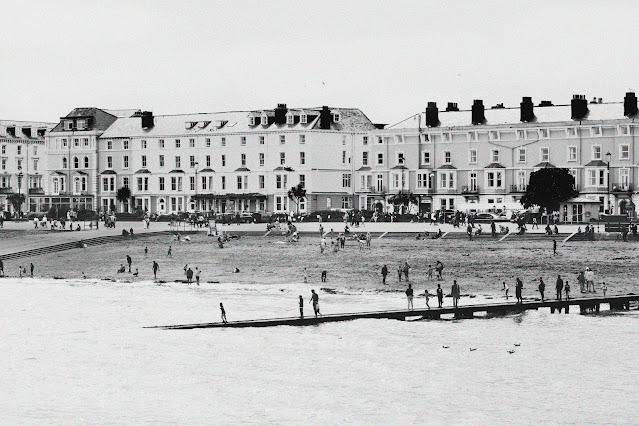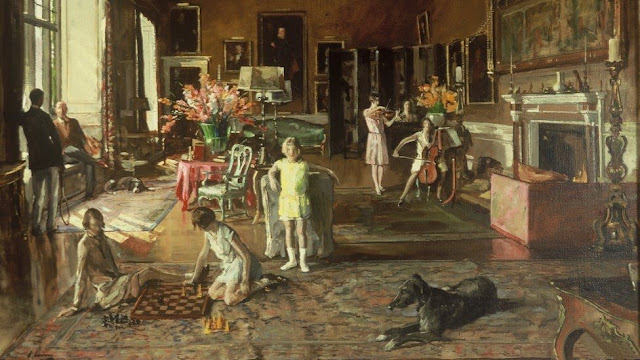I thought I would share with you a little more on our trip to Wales. A couple of things Wales has in abundance: stone and sheep. The crumbling old farm building pictured above, was only a minute's walk from our front door and in this corner of North Wales, sharing your garden with sheep is not uncommon.
I must give a timely shout out to our faithful VW old "new" Beetle, that somehow continues to serve the needs of two six foot plus males, an adult female and a week's worth of luggage in transporting us here. Not for us the gas guzzling people carriers or cars on steroids as I think of them. No, when we holiday, we'd rather squeeze almost everything we own into a two door car shaped like an insect and sit with our knees raised up to our ears!
Before anyone points out the titular spelling error, there will be reference to one of the Mersey Beat pioneers coming up, but I digress. It transpires that the bug is very adept at making small items disappear. On the third morning of our holiday in Wales, we managed to lose the sacred front door key, after forgetting rule number 1, which was to leave it in the key safe upon leaving the property. Luckily, our son had stayed behind for a couple of hours (inexplicably he didn't fancy accompanying me to an old graveyard) and was able to let us back into the property.
Not much to report on the 19th century church incidentally. It is no longer used for worship, the stone signage indicating the new occupant's business there.
The building is now being used as an artist and sculptor's workshop and was cordoned off to the public.
Back to reality, a frantic couple of hours passed as we hunted high and low - the pressure and our heart rates increasing ever so slightly when, in the midst of this search, the owner emailed to check if everything was OK. Finally, after retracing our steps around the graveyard and after the forty third check of the car's interior, Gareth found the key lodged between the driver's seat and the seatbelt. Phew!
Here are some village views and glimpses of the hills surrounding our valley. Everywhere you look, the land is divided by stone walls and many of the older buildings are made from what is known as "rubble stone."
However, perhaps the most impressive local stone building was Conwy Castle, a mere 15 minute drive away and an exceptionally well preserved medieval castle fortress. Built by architect Master James of St George at the bidding of Edward I in a staggering 4 years between 1283 and 1287, the cost of the build was an eye watering £15,000. Here's our first glimpse, as photographed through the windscreen.
The 13th century castle walls encapsulate the town and accordingly, you are never more than a few steps away from a view of the castle walls.
I'm really not good with heights and as the entry fee principally invites access to the castle's numerous towers, it would be entirely wasted on me. Instead, we opted to separate. The two boys elected to walk the castle walls around the town, as I stalked them through the streets with my camera. For the record, I did try. I got as far as the top of the first level of rusty iron access steps before spotting this rather nervous looking dove sheltering in the castle wall. A kindred spirit? As the steps felt a little creaky and wobbly and had gaps between them (another big negative for me), I swiftly descended to the safety of the street.
As I did so, I spotted this crucifixion statue outside St Michael's Catholic Church, just as the afternoon sun passed over, rewarding me with this glorious sunburst.
This marble tablet, depicting the two Marys and created by G. Rinvolucri, is one of twelve adorning the town walls.
Dating back to the mid twentieth century, Rinvolucri was an Italian architect who came to Wales originally as a prisoner of war. He lived and worked in the Conwy area and designed several Roman Catholic churches in the area. The aforementioned church was built in the inter-war period as it is not shown on the 1913 Ordnance Survey. None of the sculptures is signed or dated, but all have dedications.
The work is Grade II listed for its special interest as a fine mid 20th century devotional sculpture forming the focus of the group of distinctive tablets, all of exceptional quality, on the medieval town walls.
Mercifully, I made the right call in not joining the boys on the town walls and instead, stalking them with my camera through the Conwy streets.
The consensus was that the walk was, in parts, "terrifying" with the safety barriers next to useless and very easy to topple over.
In complete contrast, we opted to visit the coastal town of Llandudno, situated on the Creudynn Peninsula pushing out into the Irish Sea. It takes its name from the town's saint, St Tudno.
Llandudno epitomises British seaside resorts and just about ticks every seaside tradition and is perhaps a quieter, more sedate, slightly old fashioned choice of destination as opposed to somewhere like Brighton for example.
Saint Tudno is said to have been one of the seven sons of King Seithenyn, whose legendary kingdom, Cantref y Gwaelod in Cardigan Bay, was submerged by tidal activity. According to the theory, Tudno studied at St Dunawd's college in the monastery of Bangor Iscoed, in order to make recompense for the drunken incompetence of his father, which had led to the loss of the kingdom under the waves.
As the story goes, Tudno headed to the great limestone outcrop jutting from the peninsula, known as the Great Orme...
...to bring Christianity to its people. Tudno originally lived as a hermit in a cave, utilising a nearby spring, before building up his church from there. Nothing remains of the original 6th century church, but its 12th century replacement, named after Tudno, still stands today...
...with its spectacular adjoining Great Orme Cemetery and imposing headstones, which opened in 1903.
This extensive off shore wind farm in the Irish Sea, was visible on the horizon from the cemetery site.
Much of the town as we know it today came into being in the Victorian era. The Great Orme itself, standing at 207 metres tall, is home to several large herds of wild Kashmiri goats, descendants of a pair given by Queen Victoria to Lord Mostyn.
Now, if I thought for one second that Llandudno is an adrenalin-free zone, I swiftly revised that opinion on our drive up and around the Great Orme, taking the dramatic toll road. The stop and start nature of our ascent was particularly hair-raising and a fully functioning hand brake was essential when giving way to The Great Orme Tramway, which also services the route to the summit.
For those who want to go even higher, there is a cable car option for the return trip. As you might expect, I was quite happy to photograph these from ground level.
The views winding our way back around the toll road into town were spectacular.
Copper mining, fishing and agriculture were the town's principal sources of employment, but these days, Llandudno is a traditional coastal tourist "fun town". From slapstick puppet Punch and Judy shows (which have 16th century Italian origins and have remained popular on these shores)...
...to the 700 m long Grade II listed pier (the longest in Wales),
complete with amusement arcade, fun fair, ferris wheel...
...souvenir stalls, cafes and eateries.This scene on Llandudno's sea front, photographed from the pier on our trip, must lurk in countless photo albums from decades gone by. Unusually for me, I over exposed it slightly and added a little grain in the edit, to capture that simultaneously timeless and time faded feel.
On the sea front, there were abandoned pushchairs as parents and children revelled with wild abandon, in the unprecedented warm Welsh sunshine, skimmed stones and paddled in the sea.
All life is here.
Back in town, that other famous "Beatle" - a gilded John Lennon, was spotted posing with tourists, alongside his wife, Yoko.
A girl was making her way through a cloud of bubbles....
...and in the summer of 2022, locals eschewed summer getaways in favour of a staycation.
But soon, the party (and summer) will be over. This lady already has her mind focused on the impending cost of living crisis.
But before all that, there's still time to linger in sunny season a little longer. I'll endeavour to conclude the Welsh travelogue next week. I can't promise there won't be another church. For an atheist, I do seem to spend a lot of time frequenting old churches and graveyards, but trust me, this one's special.









































































